History
Ciudad Evita was established in 1947 by Argentine President Juan Perón in Decree No. 33221 as a planned community, and the initial settlement was developed by the Eva Perón Foundation. Perón's decree stipulated that this new suburb of Buenos Aires be named after the namesake of the foundation, his wife Eva "Evita" Duarte de Perón, and was named "Ciudad Evita" meaning Evita City in Spanish. the city's original 15,000 homes were designed in a simplified Spanish Colonial Revival style favored during the Perón era, and allegedly featured a street layout built in the shape of Eva Perón's profile, which seemingly "waved" to airline passengers from Ministro Pistarini International Airport, located 6 kilometers (4 mi) south of the city. [2]
In 1955, following the Revolución Libertadora military coup that deposed Perón, the city's overt homage to the influential first lady prompted Ciudad Evita's renaming to Ciudad General Belgrano, in honor of General Manuel Belgrano. The city was administered by Banco Hipotecario following the coup, which covered all administrative activities except for some public services that were provided by the Municipality of La Matanza. The city continued to grow, incorporating the Barrio Vemme ward between 1960 and 1967. Ciudad Evita was transferred to La Matanza Council in 1963, and upon the return of Peronists to power in the 1973 general election, the city's name was reverted to Ciudad Evita. A second addition, Barrio Alas, was opened in 1974 for Argentine Air Force officers stationed at the Morón Air Base.
The March 1976 coup ousted the Peronist government and again led to a change of name for the town, this time to Ciudad General Martín Miguel de Güemes, in honor of General Martín Miguel de Güemes. The return of democracy in the 1983 general election led to the city's name being reverted to Ciudad Evita again, and the city was chosen as the site of the Buenos Aires Temple of the Church of Jesus Christ of Latter-day Saints which was dedicated in 1986. Ciudad Evita was declared a National Historic Monument of Argentina in 1997.
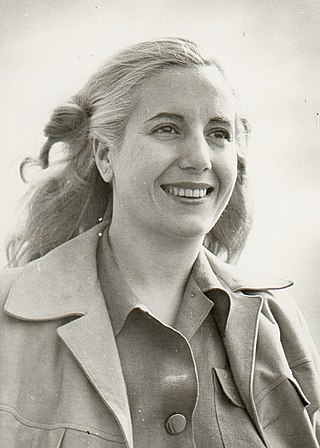
María Eva Duarte de Perón, better known as just Eva Perón or by the nickname Evita, was an Argentine politician, activist, actress, and philanthropist who served as First Lady of Argentina from June 1946 until her death in July 1952, as the wife of Argentine President Juan Domingo Perón (1895–1974). She was born in poverty in the rural village of Los Toldos, in the Pampas, as the youngest of five children. In 1934, at the age of 15, she moved to the nation's capital of Buenos Aires to pursue a career as a stage, radio, and film actress.
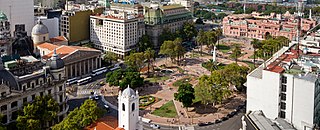
The Plaza de Mayo is a city square and the main foundational site of Buenos Aires, Argentina. It was formed in 1884 after the demolition of the Recova building, unifying the city's Plaza Mayor and Plaza de Armas, by that time known as Plaza de la Victoria and Plaza 25 de Mayo, respectively. The city centre of Buenos Aires, Plaza de Mayo has been the scene of the most momentous events in Argentine history, as well as the largest popular demonstrations in the country. On the occasion of the first anniversary of the May Revolution in 1811, the Pirámide de Mayo was inaugurated in the square's hub, becoming Buenos Aires' first national monument.

A partido is the second-level administrative subdivision only in the province of Buenos Aires, Argentina. They are formally considered to be a single administrative unit, usually contain one or more population centers, and are divided into localidades. The subdivision in partidos in Buenos Aires Province is distinct from all other provinces of Argentina, which call their second-level subdivisions departamento and are further subdivided into distinct municipalities.
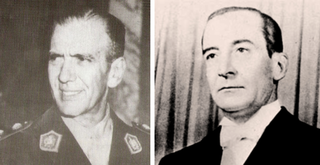
Revolución Libertadora was the coup d'état that ended the second presidential term of Juan Perón in Argentina, on 16 September 1955.

The Eva Perón Foundation was a charitable foundation begun by Eva Perón, a prominent Argentine political leader, when she was the First Lady and Spiritual Leader of the Nation of Argentina. It operated from 1948 until it was forcibly dissolved by the military after the 1955 coup d'etat.
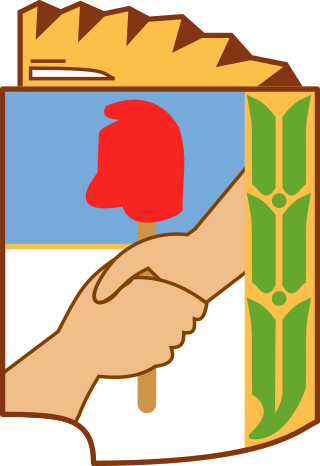
The Female Peronist Party was an Argentine political party created in 1949 and dissolved in 1955. The party only accepted women and was founded by Eva Perón, who was also the first president of the party.

Isaac Francisco Rojas Madariaga was an Argentine Admiral of the Navy and de facto Vice President of Argentina. He joined the Argentine Navy and had an unremarkable career until the 1946 election of Juan Perón.

Villa Lugano is a barrio (neighbourhood) in Buenos Aires, Argentina, located in the south of the city. It has a population of approximately 114,000 people. It is delimited by Avenida Eva Perón, Avenida General Paz, Calle José Barros Pazos, Avenida Lisandro de la Torre, Avenida Coronel Roca and Avenida Escalada. To the south-east it limits with La Matanza Partido.
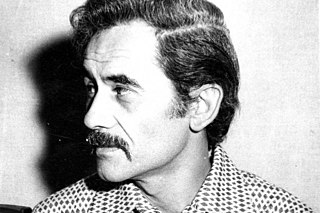
José Ignacio Rucci was an Argentine politician and union leader, appointed general secretary of the CGT in 1970. Close to the Argentine president Juan Perón, and a chief representative of the "syndical bureaucracy" ; he was assassinated in 1973.
The history of Argentina can be divided into four main parts: the pre-Columbian time or early history, the colonial period (1536–1809), the period of nation-building (1810–1880), and the history of modern Argentina.
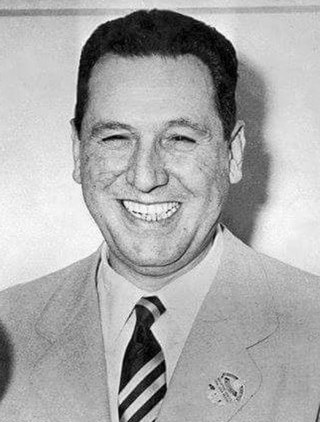
General elections were held in Argentina on 11 November 1951. Voters chose both the President of Argentina and their legislators. This was the first election in the country to have enfranchised women at the national level. Turnout was around 88%.
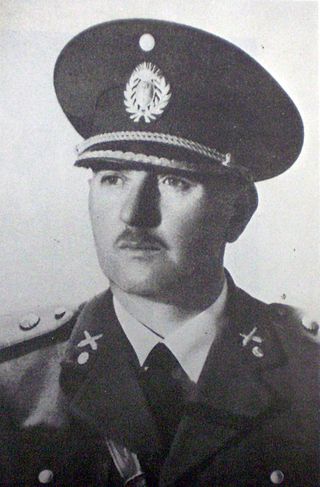
Domingo Mercante was an Argentine military officer and governor of the province of Buenos Aires. He stood out as one of the initiators of Peronism, organizing labor mobilizations that ended on 17 October 1945 with the release of Juan Domingo Perón.
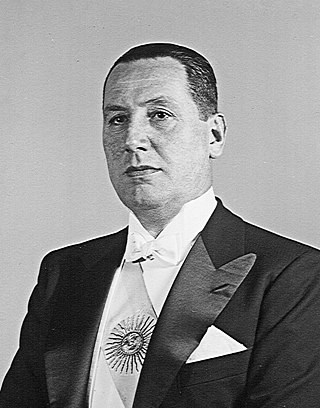
Juan Domingo Perón was an Argentine Army lieutenant general and politician who served as President of Argentina from 1946 to his overthrow in 1955, and again from October 1973 to his death in July 1974. He had previously served in several government positions, including Minister of Labour and Vice President under presidents Pedro Pablo Ramírez and Edelmiro Farrell.

The Ministry of Public Works Building, now known as the Ministry of Health Building is a public building in the rationalist style located on the intersection of 9 de Julio Avenue and Belgrano Avenue, in the neighborhood of Monserrat, in Buenos Aires, Argentina. It is currently used by the Ministry of Health of Argentina.

The Federal Popular Union, formerly the Popular Union until 2020, is a centre-right political party in Argentina rooted in Peronism. Established by Juan Atilio Bramuglia as a contingency for Peronists displaced by the 1955 military coup against the populist President Juan Perón, it became a "neo-Peronist" alternative to the exiled leader's line, and subsequently, an alternative to the successive dominant factions in the Justicialist Party.

The Buenos Aires Legislature Palace houses the Legislature of the City of Buenos Aires, Argentina. It is an architectural landmark in the city's Montserrat district, situated in a triangular block bounded by the streets Hipólito Yrigoyen Street, Presidente Julio A. Roca Avenue and Perú Street. Built of grey granite, it has a Neoclassical design. The building is open to the public on week-days only. The building contains the Esteban Echeverría Library, Salón Rosado, and a carillon which, when it was installed in 1930, was the largest in South America.
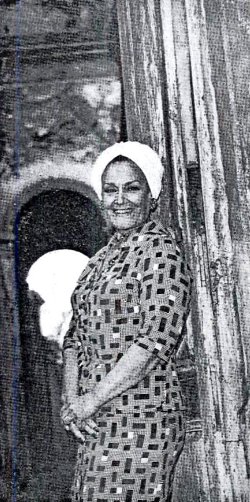
Juana Larrauri de Abramí, also known as Juanita Larrauri was a tango singer and was among a group of the first women elected to the Argentine Senate. She was elected twice as a senator and in both cases lost her seat as a result of right-wing military coups; she was elected in 1951 and lost her seat in 1955, then was elected again in 1973 and lost her seat again in 1976.

Ricardo César Guardo was an Argentine dentist and politician. He served as a National Deputy elected in Buenos Aires from 1946 to 1952, and as President of the Chamber of Deputies from 1946 to 1948. A member of the peronist Justicialist Party, he also briefly served as Minister of Defense during the presidency of Isabel Perón in 1976 and as Argentina's ambassador to the Holy See from 1974 to 1976.

Alberto Luis Rocamora was an Argentine politician. A member of the Justicialist Party, he was an early supporter of President Juan Perón and his entire career unfolded as a member of the Peronist Movement.



















